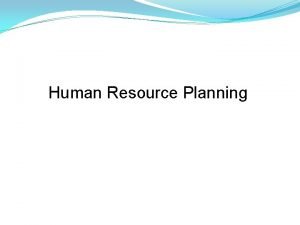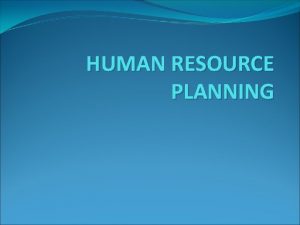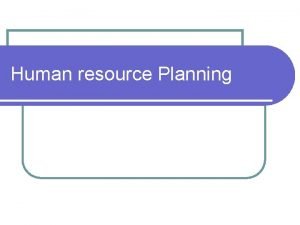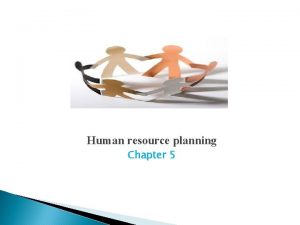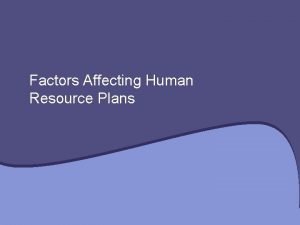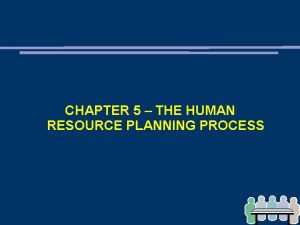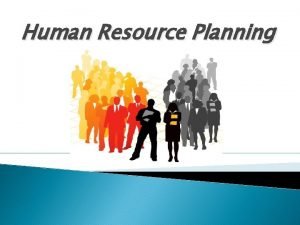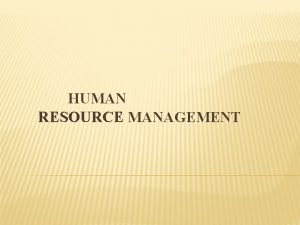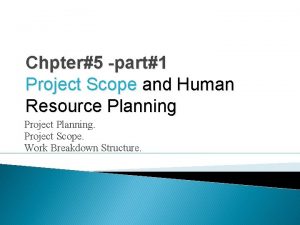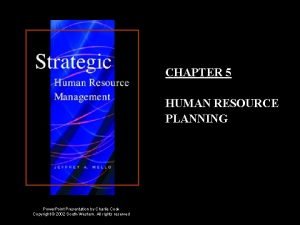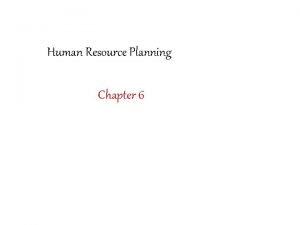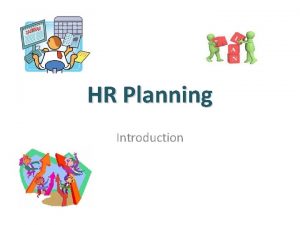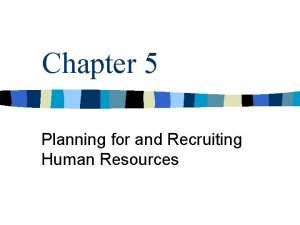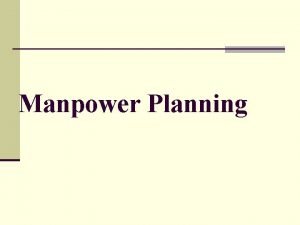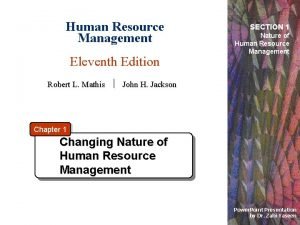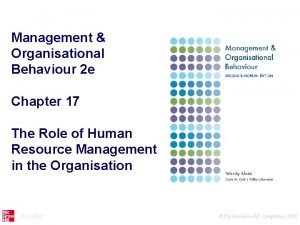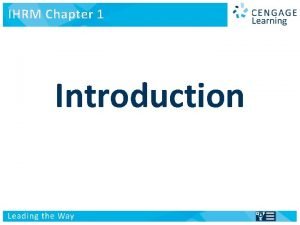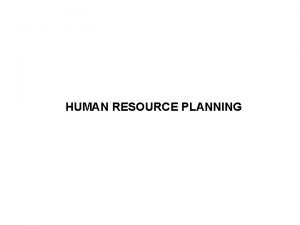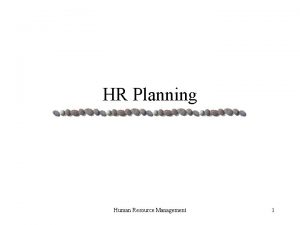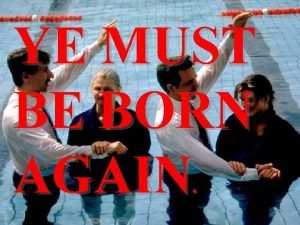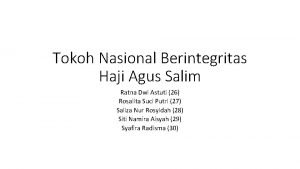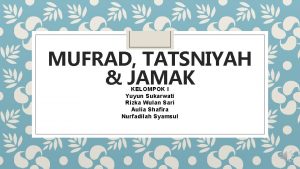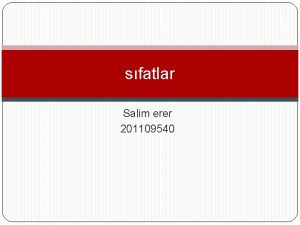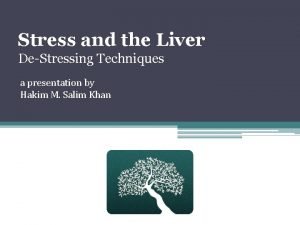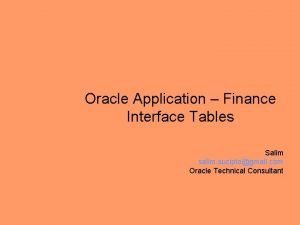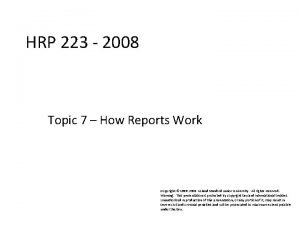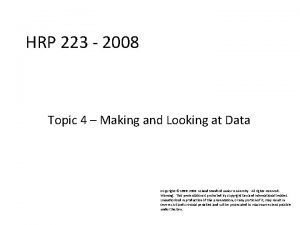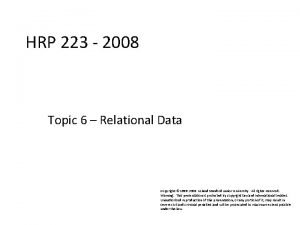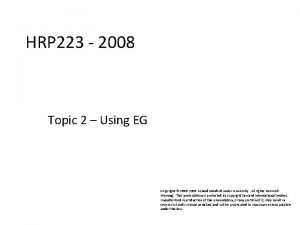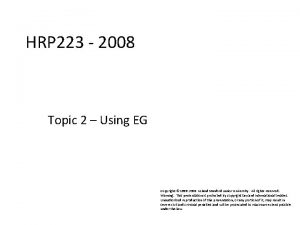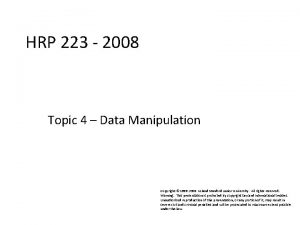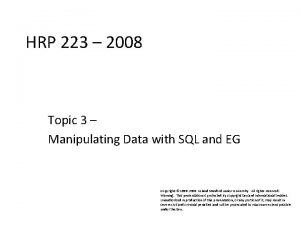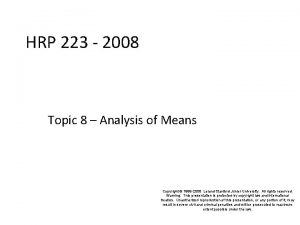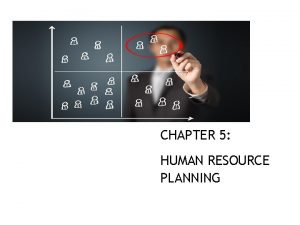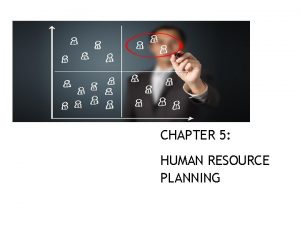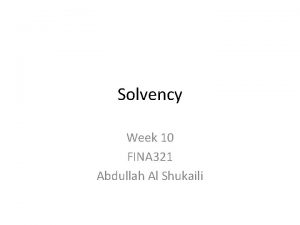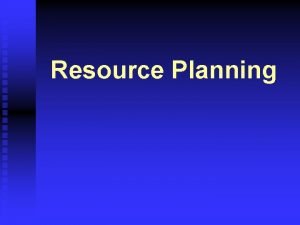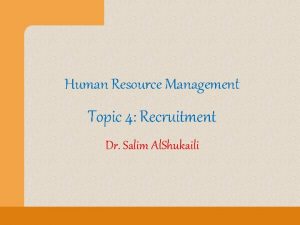Human Resource Planning HRP Dr Salim Al Shukaili































- Slides: 31

Human Resource Planning (HRP) Dr. Salim Al. Shukaili

5– 2 Chapter Objectives After you have read this chapter, you should be able to: Define HR planning and outline the HR planning process. Describe the means for assessing the external and internal workforce in HR planning. Identify methods forecasting HR supply and demand levels.

Human Resource Planning (HRP) HR Planning is to make predictions of future needs of the organization according to the organization goals and develop action plans for meeting the needs in the future. HR Planning is part of the organization’s strategic planning. Human resource planning is the term used to describe how companies ensure that their staff are the right staff to do the jobs.

HR manager ensures that the company has the right type of people in the right number at the right time and place, who are trained and motivated to do the right kind of work at the right time.

5– 5 Effective HR Planning Right people Right capabilities Right times Right places

5– 6 1. HRP (Definitions): Human Resource Planning ―the process of determining manpower requirements and the means for meeting those requirements in order to carry out the integrated plan of the organization. Process of anticipating and making provision for the movement (flow) of people into, within, and out of an organization.

The process of analyzing and identifying the need for and availability of human resources so that the organization can meet its objectives. The process of systematically reviewing human resource requirements to ensure right skills are available.

5– 8 HR Planning Responsibilities Top HR executive and subordinates gather information from other managers to use in the development of HR projections for top management to use in strategic planning and setting organizational goals.

5– 9 2. HRP (Objectives): Ensure optimum use of human resources currently employed. Provide balances in the distribution and allocation of human resources. Assess or forecast future skill requirements of the organization's overall objectives. Provide control measure to ensure availability of necessary resources when required. Control the cost aspect of human resources. Formulate transfer and promotion policies.

5– 10 HRP (The Importance): Shortage of qualified resources to fill jobs Wider span of retirement options Need for life-long learning Reduce personnel costs by anticipating shortages and surpluses Resistance of employees to change and organizational demand for it Provide informed base for planning employee development

5– 11 HRP (Benefits ): Encouragement of Proactive Rather Than Reactive Behavior Explicit Communication of Company Goals Stimulation of Critical Thinking and Ongoing Examination of Assumptions Identification of Gaps Between Current Situation and Future Vision Encouragement of Line Managers’ Participation Identification of HR Constraints and Opportunities Creation of Common Bonds

HRP (The Challenges): Maintaining a Competitive Advantage Reinforce Overall Business Support Avoiding Excessive Concentration on Day-to. Day Problems Developing HR Strategies Suited to Unique Organizational Features

Coping with the Environment Securing Management Commitment Translating the Strategic Plan into Action Combining Intended and Emergent Strategies Accommodating Change

Features of HRP: Consistency: consistent to organization goals. Continuity: between long-term, mid-term and short-term. Flexibility: adapting according to change. Accuracy: be as close as possible to reality.

HRP Part 2

The Human Resource Planning Process ü Project future human resource supply ü Forecast future human resource needs ü Compare forecast needs with projected supply ü Plan policies and programs to meet human resource needs ü Evaluate human resource planning effectiveness

Forecasting HR Supply and Demand Forecasting Using information from the past and the present to identify expected future conditions. Types of Forecasts HR Demand Internal Supply External Supply

5– 18 Forecasting: Needs and Uses • • Scheduling existing resources How many employees do we need and when? How much product should we make in anticipation of demand? Acquiring additional resources When are we going to run out of capacity? How many more people will we need? How large will our back-orders be?

5– 19 • Determining what resources are needed • What kind of machines will we require? • Which services are growing in demand? declining? • What kind of people should we be hiring?

HR PLANNING Strategic Planning Human Resource Planning Forecasting Human Resource Requirements Comparing Requirements and Availability Forecasting Human Resource Availability Demand = Supply Surplus of Workers Shortage of Workers No Action Restricted Hiring, Reduced Hours, Early Retirement, Layoff, Downsizing Recruitment Selection

Forecasting HR Requirements (Demand) 4 Demand for firm’s goods or services must be forecast 4 Estimate of numbers and kinds of employees the organization will need at future dates 4 Forecast is then converted into people requirements

Forecasting HR Availability (Supply) 4 Determining whether the firm will be able to secure employees with the necessary skills, and from what sources these individuals may be obtained 4 Show whether the needed employees may be obtained from within the company, from outside the organization, or from a combination of the two sources

Conditions and Select Responses 1. Labour Demand Equals Labour Supply • No replacements of quits from inside or outside • No recruiting • No early retirements • No additional training • Do internal transfers and redeployment

Conditions and Select Responses 2. Labour demand is less than available supply Surplus of Employees • • • Reduction Demotion Voluntary early retirement Termination Layoffs

Conditions and Select Responses 3. Labour Demand Exceeds Labour Supply Shortage of Workers Forecasted • Training/ retraining • Creative recruiting • Succession Planning • Compensation incentives • Promotion from within • External recruitment • Subcontracting • Par-time/temporary workers • Training programs • Overtime work

Human Resource Information Systems (HRIS) Human resource information systems (HRIS): An integrated system of hardware, software, and databases designed to provide information used in HR decision making. Benefits of HRIS Administrative and operational efficiency in compiling HR data Availability of data for effective HR strategic planning Automation of payroll and benefit activities

Designing and Implementing an HRIS Design Issues What information available and what is information needed? To what uses will the information be put? What output format compatibility with other systems is required? Who will be allowed to access to the information? When and how often will the information be needed? 2– 27

5– 28 The HRIS Department’s responsibilities: Identification, planning, and implementation of HRIS changes and updates in order to meet the strategic needs of the Division of Human Resources. Project implementation to simplify time-consuming transactions through the automation of administrative. tasks and departmental workflows, and foster a paperless and more efficient working environment. Production support activities such as technical data analysis, upgrade testing, and documentation of Human Resources processes.

5– 29 To provide information and statistical reports to internal and external customers. Support, analyze, and maintain the HR web site and provide web technology solutions and services to improve the efficiency of Human Resources business processes, effectiveness of HR services and programs to customers. To recommend and implement HRIS projects based on production issues and/or departmental IS needs.

Uses of HR Information System (HRIS)

5– 31 The End
 Zero-base forecasting
Zero-base forecasting Long term hr planning
Long term hr planning Meaning of manpower planning
Meaning of manpower planning Definition of hrp
Definition of hrp Resource forecasting meaning
Resource forecasting meaning Steps of human resource planning
Steps of human resource planning Recruitment and selection question paper
Recruitment and selection question paper Factors affecting human resource management
Factors affecting human resource management Supply forecasting techniques in hrp
Supply forecasting techniques in hrp Human induction meaning
Human induction meaning Swot analysis of hr department
Swot analysis of hr department Geister meaning
Geister meaning Wbs human resource management
Wbs human resource management Human resource planning powerpoint presentation
Human resource planning powerpoint presentation Human resource planning cycle
Human resource planning cycle What is planning
What is planning Chapter 5 planning for and recruiting human resources
Chapter 5 planning for and recruiting human resources Macro level manpower planning
Macro level manpower planning Nature of human resources management
Nature of human resources management Markov employee transition
Markov employee transition Harvard model of hrm
Harvard model of hrm International human resource planning
International human resource planning Importance of human resource planning
Importance of human resource planning Wastage analysis in hrp
Wastage analysis in hrp Human resource planning wikipedia
Human resource planning wikipedia Aenon near salim
Aenon near salim Maria zenibiyang
Maria zenibiyang Salim ogur
Salim ogur Birth of prince salim
Birth of prince salim Contoh jamak muannats salim
Contoh jamak muannats salim Sıfatların çeşitleri
Sıfatların çeşitleri Hakim salim khan
Hakim salim khan


